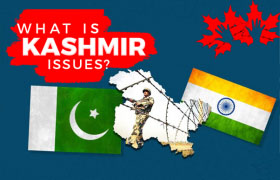Islamabad
Kashmir has once again emerged as a major flashpoint between South Asia’s nuclear-armed rivals, India and Pakistan as the Indian government repealed Kashmir’s special status in August 2019, says a report.
The report titled ‘Toward a Kashmir Endgame? How India and Pakistan Could Negotiate a Lasting Solution’ is written by Happymon Jacob, an Associate Professor of diplomacy and disarmament at the Jawaharlal Nehru University in New Delhi, and released by the US Institute of Peace (USIP) on its website.
It says that Kashmir has been a cauldron of discontent since August 2019, when the Indian government altered the special constitutional status of Jammu and Kashmir and split it into two union territories under direct administration of New Delhi.
It says that for now, the Indian government seems to have closed off options for a negotiated settlement of Kashmir with Pakistan as well as with pro-freedom parties in Indian illegally occupied Jammu and Kashmir. It says that New Delhi’s strategy is to tighten its control of Kashmir while creating space for more pro-India politics. But this approach has intensified disaffection in Kashmir, it adds.
The report says that the Indian government’s August decision on Kashmir was unpopular within Kashmir but enthusiastically welcomed in India. Even members of the opposition Congress party supported the revision of Article 370, if not the bifurcation of IIOJK into two union territories.
It says that making the decision was easy for the Modi government but implementing it has been more challenging and dealing with its long-term aftermath will be more difficult still. The question presents itself: does New Delhi have a carefully conceived, long-term policy to stabilize Kashmir and bring it into the mainstream of India’s polity? it adds.
The report states that New Delhi’s strategy is to create space in the valley for more pro-India politics – that is, for political activity that embraces the notion of Kashmir as an integral part of India. It says a new political party named the Apni Party, led by Altaf Bukhari, a former member of the Peoples Democratic Party (PDP), has already emerged as an alternative political formation in the valley.
The report maintains that New Delhi’s tight control over IIOJK seems unlikely to be relaxed soon as the process of lifting restrictions on the Internet is proceeding only gradually. It says although the US State Department and the European Union have raised concerns over continued blocking of the Internet, on May 11, 2020, the Supreme Court of India rejected petitions demanding restoration of 4G Internet services in the occupied territory.
The report says that the prospect of forced demographic changes worry Kashmiris. Fears of a flood of non-Muslims into Kashmir may well be unwarranted, however, it adds.
It says New Delhi claims that the Pakistani part of Kashmir belongs to India, which will incorporate the territory into India at some point in the future. “One example of this approach is provided by India’s Meteorological Department, which now refers to its meteorological subdivision of Jammu and Kashmir as “Jammu & Kashmir, Ladakh, Gilgit-Baltistan and Muzaffarabad [areas within Pakistan-controlled Kashmir],” a term that is repeated in every daily weather forecast,” it says.
In short, whereas New Delhi’s traditional strategy was to arrive at a negotiated settlement of the Kashmir dispute with Pakistan and the Kashmiri leadership, its new strategy emphasizes the domestic political management of Kashmir, the report maintains.
The report states that in the immediate aftermath of the August decision by New Delhi, Pakistan launched an international diplomatic campaign to condemn and discredit the Indian action in Kashmir. Pakistan highlighted the human rights impact of India’s new Kashmir policy, as well as its bilateral and regional implications, it adds.
It says Pakistan’s Prime Minister, Imran Khan, convened a meeting of the country’s National Security Committee, called India’s move unilateral and illegal, and suspended bilateral trade with India. “Pakistan also ordered India’s ambassador to Pakistan to leave the country and pulled back its own ambassador-designate from the New Delhi posting. Khan also raised the issue on the floor of the UN Security Council,” it says.
The report says that the second piece in Pakistan’s grand strategy has been to enlist the support of the international community in its campaign against India’s Kashmir policy. It adds that many members of the international community have listened to Pakistan’s complaints and have shared their concerns about New Delhi’s Kashmir policy.
It says that since August 2019, New Delhi has, time and again, argued that it will not engage in a conversation with Pakistan on the Kashmir question, except to discuss the status of Azad Kashmir. However, it adds, Pakistan has insisted that no talks with India can be held until India rolls back the Kashmir decision. If Pakistan was to begin talks with India, Pakistan would be indicating that it has accepted the revised status quo in Kashmir, it adds.
The report says that one potential way forward could be to embark upon a step-by-step process. The first step, it says, could be to institute a backchannel conversation mandated to discuss issues relating to conflict management mechanisms, rather than conflict resolution, between the two sides.
The report adds that the backchannel could discuss subjects such as putting in place a written ceasefire agreement to stabilize the Line of Control and establish regular face-to-face meetings between the directors general of military operations of the two armed forces. Once such a discussion starts, it says, it might well generate some bilateral goodwill, which the two adversaries can build on to negotiate a resumption of the cross-LoC trade that was suspended in 2019 and a reinstatement of other Kashmir-specific confidence-building measures, such as cross-border bus services. If the two sides are able to negotiate and implement those measures, they can then consider appointing special envoys to discuss a potential way forward to resolve the Kashmir dispute, it maintains.—KMS










